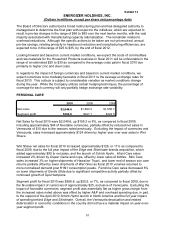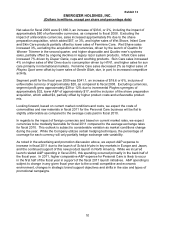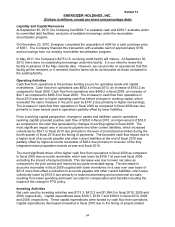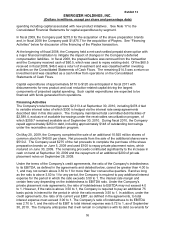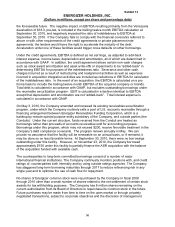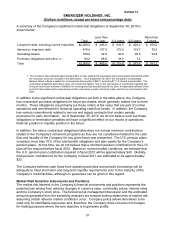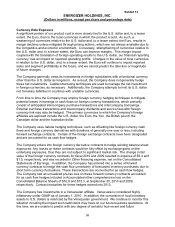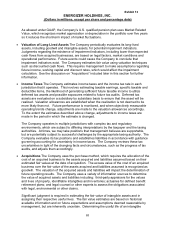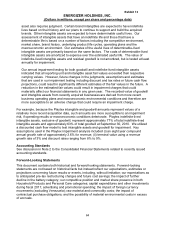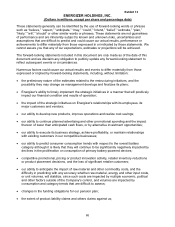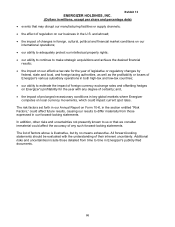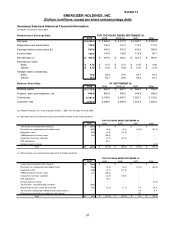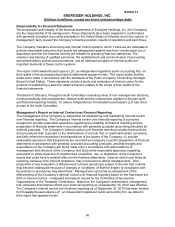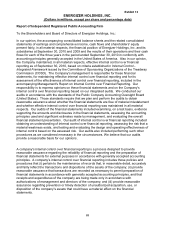Energizer 2010 Annual Report Download - page 71
Download and view the complete annual report
Please find page 71 of the 2010 Energizer annual report below. You can navigate through the pages in the report by either clicking on the pages listed below, or by using the keyword search tool below to find specific information within the annual report.
Exhibit 13
ENERGIZER HOLDINGS, INC.
(Dollars in millions, except per share and percentage data)
61
related depreciation, and other costs. In general, the Company has been able to offset or
minimize inflation effects through other cost reductions and productivity improvements through
mid-2005, thus inflation was not a significant factor to that point. In recent years, the cost of
zinc, nickel, steel, oil and other commodities used in the Company’s production and distribution
have become more volatile. Looking forward, we expect the costs of commodities and raw
materials for Household Products and Personal Care to be unfavorable in fiscal 2011 as
compared to average costs paid in fiscal 2010 by an estimated amount ranging from $20 to $30
based on current market conditions. We cannot predict with any degree of certainty the impact
of future fluctuations in the costs of commodities and raw materials. In addition, we cannot
predict what, if any, impact the economic stimulus measures made in response to the recent
economic downturn may have on inflationary pressures over time.
Critical Accounting Policies
The Company identified the policies below as critical to its business operations and the
understanding of its results of operations. The impact and any associated risks related to these
policies on its business operations is discussed throughout Management’s Discussion and
Analysis of Results of Operations and Financial Condition, where such policies affect the
reported and expected financial results.
Preparation of the financial statements in conformity with GAAP in the U.S. requires the
Company to make estimates and assumptions that affect the reported amounts of assets and
liabilities, disclosure of contingent assets and liabilities and the reported amounts of revenues
and expenses. On an ongoing basis, the Company evaluates its estimates, including those
related to customer programs and incentives, product returns, inventories, intangible assets
and other long-lived assets, income taxes, financing, pensions and other postretirement
benefits, and contingencies. Actual results could differ from those estimates. This listing is not
intended to be a comprehensive list of all of the Company’s accounting policies.
• Revenue Recognition The Company's revenue is from the sale of its products. Revenue
is recognized when title, ownership and risk of loss pass to the customer. When discounts
are offered to customers for early payment, an estimate of the discounts is recorded as a
reduction of net sales in the same period as the sale. Standard sales terms are final and,
except for seasonal sun care returns which are discussed in detail in the next paragraph,
returns or exchanges are not permitted unless a special exception is made; reserves are
established and recorded in cases where the right of return does exist for a particular sale.
Under certain circumstances, we allow customers to return sun care products that have not
been sold by the end of the sun care season, which is normal practice in the sun care
industry. We record sales at the time the title, ownership and risk of loss pass to the
customer. The terms of these sales vary but, in all instances, the following conditions are
met: the sales arrangement is evidenced by purchase orders submitted by customers; the
selling price is fixed or determinable; title to the product has transferred; there is an
obligation to pay at a specified date without any additional conditions or actions required by
the Company; and collectability is reasonably assured. Simultaneous with the sale, we
reduce sales and cost of sales, and reserve amounts on our consolidated balance sheet for
anticipated returns based upon an estimated return level, in accordance with GAAP.
Customers are required to pay for the sun care product purchased during the season under
the required terms. We generally receive returns of U.S. sun care products from
September through January following the summer sun care season. We estimate the level
of sun care returns using a variety of inputs including historical experience, consumption
trends during the sun care season and inventory positions at key retailers as the sun care


